Don
Sorenson
A Retrospective
Works from 1976 to 1985
Marks Center for the Arts
College of the Desert
February 13-March 28, 2008
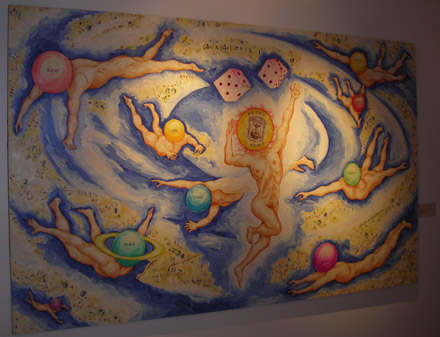
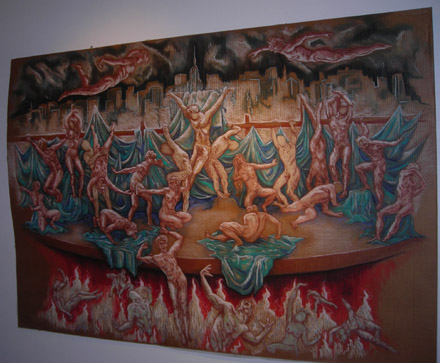
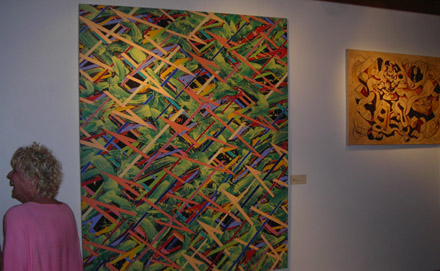
.jpg)
|
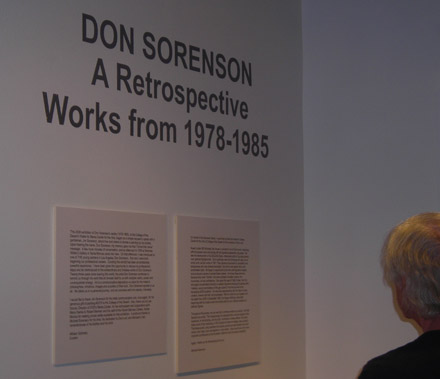
This 2008 exhibit of Don Sorenson's works, 1976 to 1985, at the
Marks Galley, College of the Desert, began as a simple request to
speak with a gentleman, Jim Sorenson, about how and where to donate
a painting by his brother. Upon hearing the name, Don Sorenson,
my memory gave me that, "I know that name" message. A
few more minutes of conversation, and an afternoon in 1978 at Nicholas
Wilder's Gallery in Santa Monica came into view. On that afternoon,
I was introduced to one of the hottest young painters in Los Angeles,
Don Sorenson. Don and I were both beginning our professional careers.
Curating this exhibit has been an emotionally powerful experience.
I have been given the opportunity to retrace my professional steps
and be reintroduced to the extraordinary and timeless works of Don
Sorenson. Twenty-three years since leaving this world, the artist
Don Sorenson continues to remind us thru his work that Art reveals
with clarity, power and unvanquished energy. Art is a depository-
a place for the maker to place philosophies, emotions, images and
a portion of their soul. Don Sorenson speaks to us all. He takes
us on a personal journey and we converse with him silently, intimately.
The Los Angeles art scene in the 1970 and 80s was well populated
with innovators- artists who had learned to believe in themselves
and began making works that became the foundation for Los Angeles'
international identity as a cultural center. It seems as though
each week was energized by several openings where new works by the
likes of John Baldessari, Sam Francis, Martha Alf, John McCracken,
Ed Moses, Robert Irwin, Joe Goode, Ron Davis and others kept the
creative atmosphere electric.
Surrounded by talents, a young Don Sorenson stepped up and made
himself known. Sorenson's commitment was to painting and his talent
as a painter was recognized. Unlike others who branched off toward
narrative, conceptual and installation art, Sorenson relied upon
Modernist structure- a grid and geometric forms- and fused it with
his personal signature of layering, splattering and a color palette
soon to be recognized as Sorenson. Don's search for a new structure
in painting created works that consisted of spatial images which
forced the work from the world of flat to the world of visual three-dimensionality.
Each work gave the viewer a world to inhabit and traverse. Although
painted more than twenty years ago, Don Sorenson's works remain
vital, mysterious and energizing.
In her 1978 catalogue essay for a retrospective of works by Don
Sorenson, art historian and writer Melinda Wortz wrote: "With
regard to content, Sorenson involves himself with painting because
of its potential for spiritual metaphor. In this regard he recalls
Agnes Martin's lecture at the Pasadena Art Museum in the early 1970s
as a pivotal influence, together with his art historical study of
writings by 20th century painters like Kandinsky, Malevich and Mondrian.
Raised in a strict Lutheran family, Sorenson had experienced ecstatic
religious visions when he was a student and more recently when practicing
Zen meditation." Unknown to Wortz at the time, Sorenson's "ecstatic
religious visions" resulted from his experimentation with mind
altering drugs. Similarly, many creative people in the 1970s experimented
with such drugs in search of the next creative plateau. On one particular
occasion, Don's experimentation resulted in a seriously physical
adverse reaction. Typical for any human, Sorenson called out to
God to stop his painful situation. As if written for and taken from
a film sequence, Don's physical reactions to the drugs ceased. Although
he never subsequently described himself as religious , his work
possessed such levels of visual complexity they could be seen as
examples of one artist's beliefs, layer upon layer until they became
one mesmerizing image.
Sorenson's early paintings illustrate his understanding and need
to challenge the formal theories of abstraction. Sorenson made works
of spatial illusions that minimized the generally held notion of
critics such as Clement Greenberg, that paintings should acknowledge
the inherent flatness of a picture plane. Sorenson's overlapping
images, layers of paint and use of order/chaos illusion set him
aside and gave his work elements that have been described by critic
Michael Duncan as "not representing or delineating a specific
space, they assume a role as fully-fleshed abstract objects- thus
achieving a kind of "pure" abstraction similar to that
desired by Malevich and Mondrian."
In the late 70s, Sorenson's curves evolved into deliberate, straight
lines weaving themselves into zigzag designs reminiscent of traditional
design motifs used by Navaho weavers in their extraordinary blankets.
Earlier works were composed of the zig-zag in combination with the
curved and diagonal lines. The paintings began with a dark monochromatic
but multi-valued background which then received a series of taped
and painted diagonal lines of alternating warm and cool hues. A
third set of thick and thin zig-zag motifs were added just before
the artist added painterly twists, splatters and drips. The taped
lines often bled into one another, adding to Sorenson's idiosyncratic
palette and an obvious collaged element to the work. Later zig-zag
paintings saw the artist eliminate the collage aspect and create
illusion from complex layers of lines intertwined until the viewer
is challenged to discern a distinction between figure and ground.
In order to give the viewer a "subject", Sorenson applied
the last zig-zags, usually in a saturated color chosen from the
artist's unorthodox palette. Even the "zig-zag" paintings
that seemingly are more monochromatic, are made from colors being
mixed with others, thus creating a range of hues.
In the early 1980s, Sorenson's complex zig-zag paintings began hiding
phantom figurative images. The artist firmly appreciated the classical
figures from the Greeks and had convinced himself that unless he
was adept at creating a figure in the classical mode, he would not
be taken seriously as an artist. He began making works that were
blatantly classical in imagery, combined with geometric designs.
His canvases often times were shaped as temple facades. Always aware
of the public, he continued to incorporate his signature, the "zig-zag"
into his more classical compositions.
A year in New York between 1981 and early 1983, produced predominately
figurative works. Sorenson spent extensive periods of time refining
his skills as an artist who could draw in a more classical manner.
Diagnosed with the HIV virus, his paintings took on a fierce emotional
energy. Some works portend scenes of "judgment day" imagery.
Many drawings Sorenson completed at this time remained lyrical and
optimistic, some contained anguished male figures. All continued
to allow the viewer to savor the artist's ability to speak with
imagery.
Sorenson's zig-zag paintings had established him as one of the most
promising artists in Los Angeles. Winning the 1984 Los Angeles County
Museum of Art Young Talent Award solidified his position in the
Los Angeles art community. Subsequent to receiving the Young Talent
Award, Sorenson seriously concentrated on yet another creative phase.
The "Ring" and "Mask paintings were jammed with a
vocabulary of images, literal and hidden. The "Ring" paintings
were the artist's personal interpretation of the Wagner masterpiece
of the same name. The "Mask" paintings were filled with
geometric shapes that intertwined in such a complex manner, the
final piece gave the viewer both literal and hidden images to contemplate
and discover.
In 1985 at the age of 36, Don Sorenson left this world, a victim
to AIDS. At the time of his death, he was respected as an artist
and yet still found himself in what has been described as an "aesthetic
upheaval". His continual search for a new visual vocabulary
in order to communicate was suddenly ended.
Sorenson's talented ability to make the tension between order and
chaos be appreciated were gifts. Don Sorenson believed that"
art can continue to present the unknown in a manner that allows
us to discover ourselves through new perceptual experience".
This 2008 exhibit of works by Don Sorenson made between 1976 and
1985 allows us all the unique and privileged opportunity to experience
self-discovery emanating from art works made by a man who perceived
the world in a superior way.
My appreciation to Jim Sorenson for his initial contact concerning
"a painting by my brother". A special thank you to Jim
and Mrs. Sorenson for their generosity in gifting painting #2279,
1979, to the College of the Desert. Don Sorenson was a gifted teacher.
He must be pleased knowing his work will be studied and become a
tool for learning. Thanks to Lisa Soccio, Gallery Director, The
Marks Gallery for her cooperation and enthusiasm for this project.
Robert Berman and the staff of the Robert Berman Gallery in Santa
Monica have provided pivotal works for this exhibition and allowed
my tasks to be completed smoothly.
My personal thanks to Mike Sorenson cannot be overstated. Mike's
dedication to preserving his brother's art works is remarkable.
Mike provided me access to rows of Don's paintings and portfolios
filled with drawings and collage. Our conversations provided me
access into the life of Don Sorenson.
My memory of meeting the young, boyishly handsome artist in 1978
has been given a vitality and wealth of knowledge I could not have
ever expected. I am more complete as a professional, but more importantly,
as a human.
William Schinsky
Curator
13 February 2008
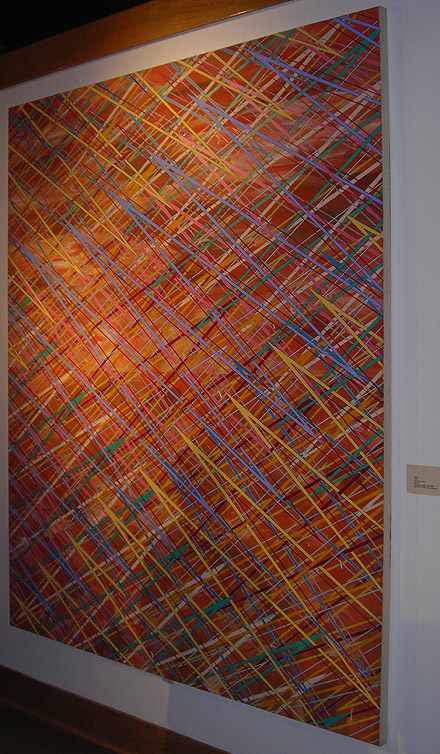
|

